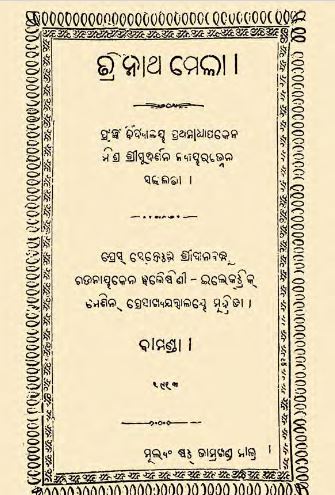Trinath Mela, a celebrated poetry collection by Sudarsan Misra, was published in 1913 and holds a significant place in the Odia literary canon. This work not only showcases Misra’s lyrical prowess but also serves as a testament to the rich cultural and spiritual heritage of Odisha. The title “Trinath Mela” refers to the grand festival dedicated to Lord Trinath, a manifestation of Lord Shiva, celebrated with much fervor and enthusiasm in the region. Through this collection, Misra captures the essence of devotion, community, and the vibrancy of life that characterizes the festival.
At its heart, “Trinath Mela” revolves around the idea of festivities and the collective experience of spirituality that unites people. The verses delve into the emotional and spiritual undercurrents that define the festival—the vibrant interactions, the ecstatic expressions of faith, and the joyous celebration of life. Misra’s poetry transcends mere description; it immerses readers in the sights, sounds, and feelings of the mela, evoking a sense of participation in the festivities.
Misra masterfully weaves themes of devotion, celebration, and nature throughout his work. The collection acts as a canvas, where he paints vivid images of pilgrims and devotees engaged in prayer, the colorful rituals, and the overwhelming sense of community that flourishes during the mela. He encapsulates the essence of collective spirituality, showcasing how these communal gatherings create bonds among individuals, transcending social barriers and differences.
What sets “Trinath Mela” apart is Misra’s unique command over language. His use of Odia idioms and phrases, coupled with influences from Sanskrit, enriches the text and adds layers of meaning. The poet’s satirical streak shines through in some verses, capturing not just the joyous aspects of the mela but also the socio-cultural contexts surrounding it. The playful rhythm and lyrical quality suggest an oral tradition, inviting readers to appreciate the musicality inherent in the Odia language.
The sub-poetry within “Trinath Mela” serves as a treasure trove of reflections on divine love and devotion. Through succinct, poignant verses, Misra conveys the inner psyche of devotees as they seek a connection with the divine. These pieces often merge Sanskrit and Odia expressions, creating a rich tapestry of spiritual thought. The use of Sanskrit not only pays homage to the linguistic heritage of Odisha but also enriches the emotional depth of the poetry, making it accessible to a broader audience familiar with spiritual literature.
In these sub-poetic expressions, the poet eloquently articulates the sentiments of longing, ecstasy, and surrender—core emotions that every devotee experiences. Each poem stands as a crystallization of mystical experiences, urging readers to introspect on their own spiritual journeys and the significance of festivals in reinforcing faith.
Trinath Mela by Sudarsan Misra remains a monumental work in Odia literature. With its rich thematic exploration of community, devotion, and life, it invites readers to experience the fervor of the festival while reflecting on the broader implications of spirituality in everyday life. Misra’s seamless blending of linguistic beauty and profound themes ensures that “Trinath Mela” is not just a collection of poems, but an enduring celebration of Odisha’s culture and the human spirit. As readers grapple with the richness of Misra’s verses, they are encouraged to find their own meaning and connection to the divine through the vibrant lens of festivity and devotion.
Books Info
| Books name | Trinath Mela |
| Author | Sudarsan Misra |
| No Of pages | 22 |
| Publisher | Smt. Urmila Devi |
| Publication | 1913 |
| Printed At | NA |
| Distributor | NA |

